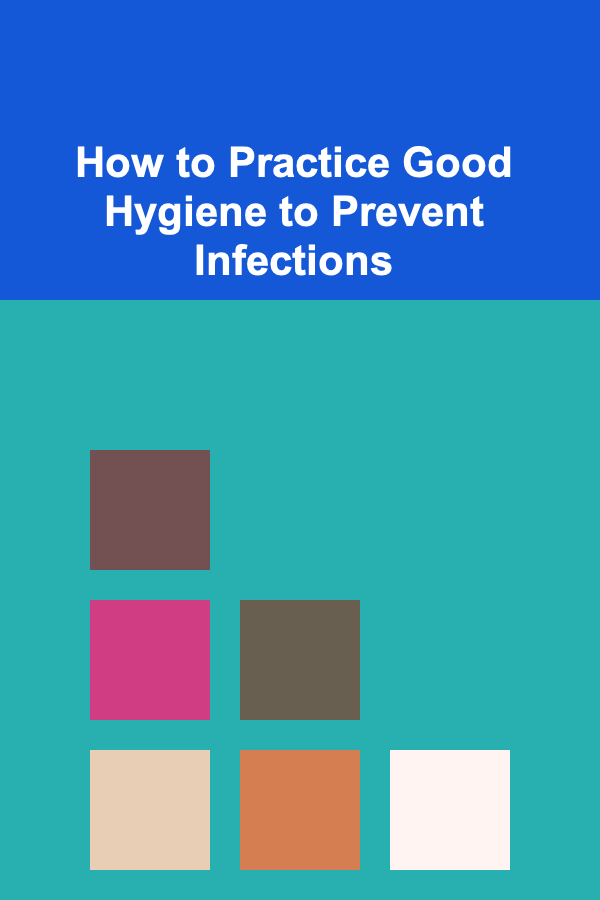
How to Practice Good Hygiene to Prevent Infections
ebook include PDF & Audio bundle (Micro Guide)
$12.99$8.99
Limited Time Offer! Order within the next:

Good hygiene is essential for maintaining personal health and preventing the spread of infections. In our everyday lives, we are exposed to various bacteria, viruses, and pathogens that can lead to illnesses. However, simple hygiene practices, when done correctly, can significantly reduce the risk of infections and contribute to a healthier life. This article will explore various ways to practice good hygiene, from basic personal care habits to environmental sanitation, and discuss their role in infection prevention.
The Importance of Hygiene in Preventing Infections
Hygiene refers to the set of practices performed to maintain health and prevent the spread of diseases. When it comes to infection prevention, hygiene serves as the first line of defense against harmful microorganisms that can cause diseases like colds, flu, gastrointestinal infections, skin infections, and more.
Infections can occur when bacteria, viruses, fungi, or parasites enter the body through direct or indirect contact. These pathogens can thrive in various environments, and without proper hygiene, they can easily spread from person to person. Practicing good hygiene is an effective way to interrupt this process and lower the chances of infection.
Hand Hygiene: The First Step to Infection Prevention
2.1 Handwashing
One of the most crucial hygiene practices is handwashing. Hands are one of the most common ways pathogens are transmitted from one person to another. Our hands come in contact with numerous surfaces, objects, and people throughout the day, all of which can harbor bacteria and viruses. Regularly washing hands with soap and water is one of the simplest yet most effective ways to prevent infections.
The World Health Organization (WHO) recommends washing hands for at least 20 seconds with soap and water, especially in the following situations:
- Before and after eating
- After using the restroom
- After coughing, sneezing, or blowing your nose
- Before preparing or eating food
- After touching potentially contaminated surfaces (such as door handles or public transport)
If soap and water are not available, using an alcohol-based hand sanitizer with at least 60% alcohol can help reduce the spread of germs.
2.2 Proper Handwashing Technique
To ensure proper hand hygiene, follow these steps:
- Wet your hands with clean water.
- Apply enough soap to cover the entire surface of your hands.
- Rub your hands together to create a lather, ensuring you clean the front, back, and between the fingers.
- Scrub your hands for at least 20 seconds.
- Rinse your hands thoroughly with clean water.
- Dry your hands using a clean towel or air dryer.
It is important to avoid touching your face, particularly the eyes, nose, and mouth, after touching potentially contaminated surfaces or objects.
2.3 Nail Care
Nails can harbor dirt and pathogens, making it essential to keep them clean and trimmed. Regularly trimming your nails and keeping them free from dirt can prevent the accumulation of harmful microorganisms. Additionally, avoid biting your nails, as this can introduce bacteria into your mouth.
Oral Hygiene: Protecting Your Mouth and Teeth
Oral hygiene plays a vital role in preventing infections, particularly those related to the mouth, throat, and gums. Poor oral hygiene can lead to the buildup of harmful bacteria in the mouth, contributing to dental problems and even systemic infections.
3.1 Brushing and Flossing
Brushing your teeth at least twice a day is essential to remove plaque, food particles, and bacteria. Use fluoride toothpaste and a soft-bristled toothbrush to gently clean your teeth and gums. Make sure to brush all surfaces of your teeth, including the front, back, and chewing surfaces. Don't forget to brush your tongue as well, as it can harbor bacteria that contribute to bad breath and infections.
Flossing should be done at least once a day to clean between your teeth and remove plaque and food particles that a toothbrush may miss. Flossing helps prevent the buildup of harmful bacteria and reduces the risk of gum disease and tooth decay.
3.2 Regular Dental Check-ups
Regular dental visits are crucial for maintaining oral health. Dentists can identify early signs of dental problems such as cavities, gum disease, or oral infections, and recommend appropriate treatments. Routine professional cleaning also helps eliminate plaque buildup that cannot be removed by regular brushing.
Body Hygiene: Maintaining a Clean and Healthy Body
Proper body hygiene is not only important for personal comfort but also for preventing skin infections and body odor caused by bacteria. Maintaining a clean body reduces the risk of fungal, bacterial, and viral infections.
4.1 Showering and Bathing
Taking regular showers or baths helps remove dirt, sweat, and bacteria from your skin. The frequency of showering may vary depending on individual needs, lifestyle, and climate, but it is generally recommended to shower at least once a day or after engaging in physical activities that cause sweating.
Use mild soap and warm water to clean your body, paying special attention to areas that are prone to sweat and bacteria buildup, such as underarms, groin, and feet. Avoid using hot water, as it can strip the skin of its natural oils, leading to dryness and irritation.
4.2 Skin Care
Keeping your skin clean and moisturized is essential for preventing infections. Dry and cracked skin can become an entry point for pathogens. Use a gentle moisturizer after showering to keep your skin hydrated and protect it from damage. Additionally, protect your skin from harsh environmental conditions by using sunscreen when outdoors.
If you have any cuts, scrapes, or wounds, make sure to clean them promptly with clean water and disinfectant. Apply an antibiotic ointment and cover the wound with a sterile bandage to prevent infection.
4.3 Preventing Body Odor
Body odor is caused by the growth of bacteria on the skin, particularly in areas such as the underarms and feet. Regular bathing, wearing clean clothes, and using deodorant can help control body odor. Choose breathable fabrics for clothing to reduce sweating, and change socks and underwear regularly to keep the skin dry and free of bacteria.
Clothing and Laundry Hygiene
Clothing can also harbor bacteria, fungi, and viruses, which can lead to infections if not properly maintained. Keeping your clothes clean is an essential part of good hygiene.
5.1 Wearing Clean Clothes
Always wear clean clothes and change them daily, especially undergarments and socks. Bacteria and fungi can thrive in damp or soiled clothing, particularly in areas where moisture accumulates, such as the groin or armpits. Make sure to wash clothes after wearing them, especially if they become soiled with sweat or dirt.
5.2 Laundry Practices
To prevent infections from spreading through clothing, wash your clothes in hot water (if appropriate for the fabric) with detergent. Drying clothes in the sun can help kill bacteria and fungi, as UV rays have antimicrobial properties. If you have been sick or exposed to contagious pathogens, consider washing your clothes and bedding separately to minimize the risk of transmission.
Environmental Hygiene: Clean Spaces, Healthier Lives
In addition to personal hygiene, maintaining a clean environment is essential for preventing infections. Pathogens can easily spread in contaminated areas, so regular cleaning and disinfecting of your living and working spaces can significantly reduce the risk of infection.
6.1 Disinfecting High-Touch Surfaces
High-touch surfaces, such as doorknobs, light switches, remote controls, and countertops, are common areas where germs accumulate. Regularly disinfecting these surfaces with a cleaning solution that contains alcohol or bleach can help kill harmful microorganisms and prevent infections.
6.2 Maintaining a Clean Home
A clean home is essential for promoting overall health. Regularly vacuuming carpets, wiping down surfaces, and cleaning bathrooms and kitchens can help reduce the buildup of germs. Pay particular attention to areas where bacteria and moisture can thrive, such as bathrooms and kitchens.
Additionally, ensure proper ventilation in your home by opening windows or using air purifiers. Proper airflow helps reduce the concentration of airborne pathogens, which can cause respiratory infections.
Personal Items Hygiene: Protecting What You Touch
Personal items, such as towels, razors, and phones, can also harbor bacteria and viruses. It's important to maintain hygiene for these items as well to reduce the risk of infections.
7.1 Towels and Personal Cloths
Towels, washcloths, and other personal fabrics should be washed regularly to prevent the accumulation of bacteria. After using a towel, make sure to hang it up to dry properly, as a damp towel provides an ideal environment for bacteria to grow.
7.2 Phone and Electronics
Phones and other personal electronics come into frequent contact with our hands, faces, and various surfaces. To minimize the spread of germs, regularly clean your phone, headphones, and other electronics using disinfectant wipes or alcohol-based cleaners.
Food Hygiene: Preventing Foodborne Illnesses
Foodborne illnesses are often caused by consuming contaminated food, which can be the result of improper handling, storage, or preparation. Good food hygiene practices are vital for preventing these types of infections.
8.1 Washing Hands Before Handling Food
Before preparing food, it is essential to wash your hands thoroughly to avoid transferring harmful bacteria to the food. This is especially important when handling raw meat, poultry, or seafood, as they can carry dangerous pathogens.
8.2 Proper Food Storage and Cooking
Store perishable foods in the refrigerator or freezer, and ensure that food is cooked to the correct temperature to kill any bacteria or viruses. Keep raw meats separate from ready-to-eat foods to prevent cross-contamination. Additionally, use clean utensils and cutting boards when preparing food.
Conclusion
Practicing good hygiene is one of the most effective ways to prevent infections and protect your health. From hand hygiene and oral care to maintaining a clean environment and practicing proper food hygiene, these habits can significantly reduce the risk of bacterial, viral, and fungal infections. By making hygiene a priority in your daily routine, you not only protect yourself but also contribute to the health and well-being of those around you.

How to Clean and Maintain Your Home's Gutters
Read More
How to Create a Relaxing and Organized Bathroom Space
Read More
How to Protect Your Home from Home Invasion and Theft
Read More
Navigate Your Journey to Leadership Excellence with an Executive Coach
Read More
How To Explore the Future of Genetic Medicine
Read More
10 Tips for Organizing Your Sewing Planner for Maximum Productivity
Read MoreOther Products

How to Clean and Maintain Your Home's Gutters
Read More
How to Create a Relaxing and Organized Bathroom Space
Read More
How to Protect Your Home from Home Invasion and Theft
Read More
Navigate Your Journey to Leadership Excellence with an Executive Coach
Read More
How To Explore the Future of Genetic Medicine
Read More